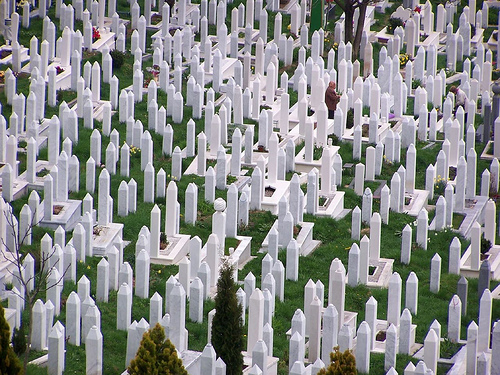Twenty years on from the start of the war, Bosnia-Herzegovina is engaged in various forms of remembrance and reflection, yet struggling to move towards the sort of reconciliation necessary to transcend the country's persistent ethnic divisions. Whilst physical traces of the war have largely disappeared, its return to normalcy has been painstakingly slow and impeded by numerous obstacles to dealing with the past.
Instead of a genuine process of reconciliation - a prerequisite for building a stable and lasting state – it has instead become a shameless game of calculation and comparisons. Although the Dayton Peace Agreement brought an end to armed violence, the war in Bosnia-Herzegovina continues by other means.
Contesting interpretations of history
6 April marked the anniversary of the start of the Siege of Sarajevo. Some 11,541 empty red chairs - symbolizing the individual victims of the 44-month siege - were laid on the streets of Sarajevo. The solemnity of the occasion, however, did not prevent the flaring of nationalist sentiments, for the President of Republika Srpska, Milorad Dodik, described the ceremony as an attempt to “use a political message to foist guilt only on Serbs, that they can only be on the bad side of history and that there are no other facts.” At the same time, many Bosniaks voiced their anger and dissatisfaction because the red chairs were imported from the so-called 'aggressor' Serbia.
Several weeks later, on 22 April, commemorations were held in Croatia, Serbia and Republika Srpska (one of Bosnia-Herzegovina's two entities) to remember the Serb, Jewish and Roma victims of genocide committed during the second World War in Jasenovac, Croatia. Almost seventy years later, Jasenovac remains a subject of contested interpretations, whereby the overall number of victims, and the responsibility of the Croatian Ustaše regime for their deaths, continue to be persistently debated.
Educating about the past
Education is key in this regard. As Croatia's president, Ivo Josipović, noted during commemorations at the Jasenovac Memorial Site, school textbooks do not contain the entire truth concerning events of the second World War. Aside from ensuring that curricula and learning materials throughout the region objectively and accurately reflect the region's troubled past, many non-government initiatives are supplementing educational efforts in support of reconciliation.
To supplement learning about the Siege, for instance, the FAMA Collection Bank of Knowledge was recently launched with the aim of bringing home the "human scale of events, places and experiences,” in order to “bridge a digital divide between the Culture of Remembrance and the Real-Time Quest for knowledge.” The FAMA Collection provides oral histories (in the form of video interviews with some 500 Sarajevo residents), a survey on the survival experience of ordinary Sarajevans during the Siege, and an interactive chronology of the Siege itself.
With respect to Bosnia-Herzegovina, however, further challenges to reconciliation loom large on the horizon. Ejup Ganić, a wartime member of the Bosnia-Herzegovina Presidency, has further strained relations between Bosniaks and Bosnian Serbs with his comment that “more Serbs died in traffic accidents than in the war in Bosnia-Herzegovina.” In Srebrenica - scene of the Bosnian war's largest massacre - the decision to refuse Bosniaks, inhabitants of the municipality prior to the war, permission to vote in forthcoming local elections, is currently causing considerable consternation.
In conclusion, however, educating about World War Two, the Socialist period, the disintegration of Yugoslavia and subsequent wars, remains a profound challenge for the entire region. With respect to Bosnia-Herzegovina, in particular, competing narratives of the war continue to plague day-to-day relations between its peoples. Establishing, recognising and remembering the truth is one of the most important components of the process of transitional justice. Whilst various initiatives have contributed in their own particular way, recognizing all victims of the wars during the nineties remains a prerequisite for securing a sustainable peace. The denial of victims – regardless of their ethno-national identity – constitutes one of the most profound obstacles to reconciliation in the former Yugoslavia.











